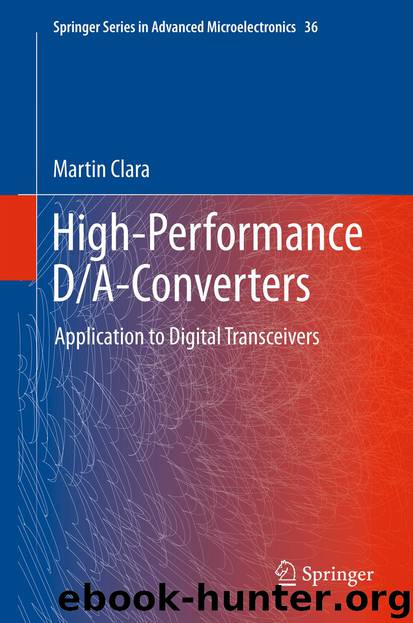High-Performance DA-Converters by Martin Clara

Author:Martin Clara
Language: eng
Format: epub
Publisher: Springer Berlin Heidelberg, Berlin, Heidelberg
4.2.8 Full-Clock Interleaved Current Cells
Time-interleaving of converters is extensively used in A/D-converters to maximize the sampling rate [134–137]. A number of identical A/D-converters can be operated in parallel and their output appropriately combined to yield a higher effective sampling rate. Also in the D/A direction the effective sampling rate can be increased by time-interleaving two or more converters [138, 139]. This not only relaxes the internal clock speed of the DAC-cores, but, more importantly for linearity, also extends their reset phase, provided that each converter performs a Return-to-Zero cycle in-between its active conversion phases. With two D/A-converter cores, the reset period is already extended to a full clock cycle.
As shown in Fig. 4.25, the overall D/A-converter then consists of two interleaved DAC-cores. Each DAC is alternately active for a full clock period during which it delivers the output current. In the following clock period the DAC-core that was active in the previous sampling period is reset, while the other DAC-core delivers the output current corresponding to the actual input data. Because the two DAC-cores process alternate data samples, a multiplexer is required from a conceptual viewpoint [133]. In a practical realization the multiplexing can be easily accomplished by triggering data latches at the input of the sub-DACs with opposite phases of a divided version of the sampling clock [140, 141].4 Naturally, this operation can also be distributed among the single DAC-cells [93]. Since current sources ideally do not influence each other when connected together at a sufficiently low-impedance summing node, an interleaved current-based D/A-converter can either be described as two (or more) identical sub-DACs or as a single DAC with as many interleaved individual current cells–both models are completely equivalent from a system perspective.
Fig. 4.25Full-clock interleaved DAC-cores
Download
This site does not store any files on its server. We only index and link to content provided by other sites. Please contact the content providers to delete copyright contents if any and email us, we'll remove relevant links or contents immediately.
| Automotive | Engineering |
| Transportation |
Whiskies Galore by Ian Buxton(41524)
Introduction to Aircraft Design (Cambridge Aerospace Series) by John P. Fielding(32883)
Small Unmanned Fixed-wing Aircraft Design by Andrew J. Keane Andras Sobester James P. Scanlan & András Sóbester & James P. Scanlan(32569)
Craft Beer for the Homebrewer by Michael Agnew(17927)
Turbulence by E. J. Noyes(7690)
The Complete Stick Figure Physics Tutorials by Allen Sarah(7135)
Kaplan MCAT General Chemistry Review by Kaplan(6589)
The Thirst by Nesbo Jo(6432)
Bad Blood by John Carreyrou(6270)
Modelling of Convective Heat and Mass Transfer in Rotating Flows by Igor V. Shevchuk(6219)
Learning SQL by Alan Beaulieu(6029)
Weapons of Math Destruction by Cathy O'Neil(5820)
Man-made Catastrophes and Risk Information Concealment by Dmitry Chernov & Didier Sornette(5641)
Digital Minimalism by Cal Newport;(5384)
Life 3.0: Being Human in the Age of Artificial Intelligence by Tegmark Max(5182)
iGen by Jean M. Twenge(5151)
Secrets of Antigravity Propulsion: Tesla, UFOs, and Classified Aerospace Technology by Ph.D. Paul A. Laviolette(4974)
Design of Trajectory Optimization Approach for Space Maneuver Vehicle Skip Entry Problems by Runqi Chai & Al Savvaris & Antonios Tsourdos & Senchun Chai(4837)
Electronic Devices & Circuits by Jacob Millman & Christos C. Halkias(4739)
